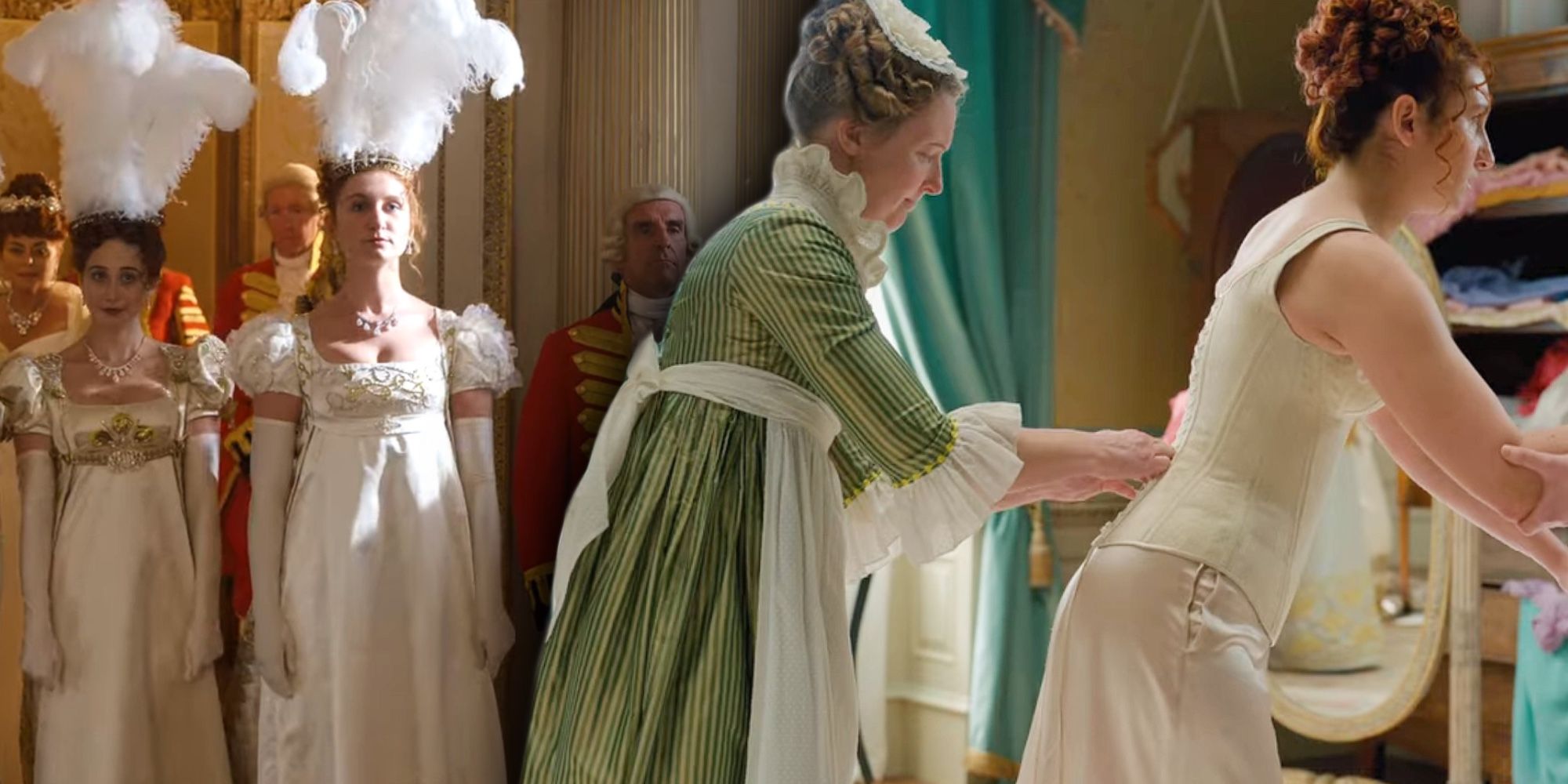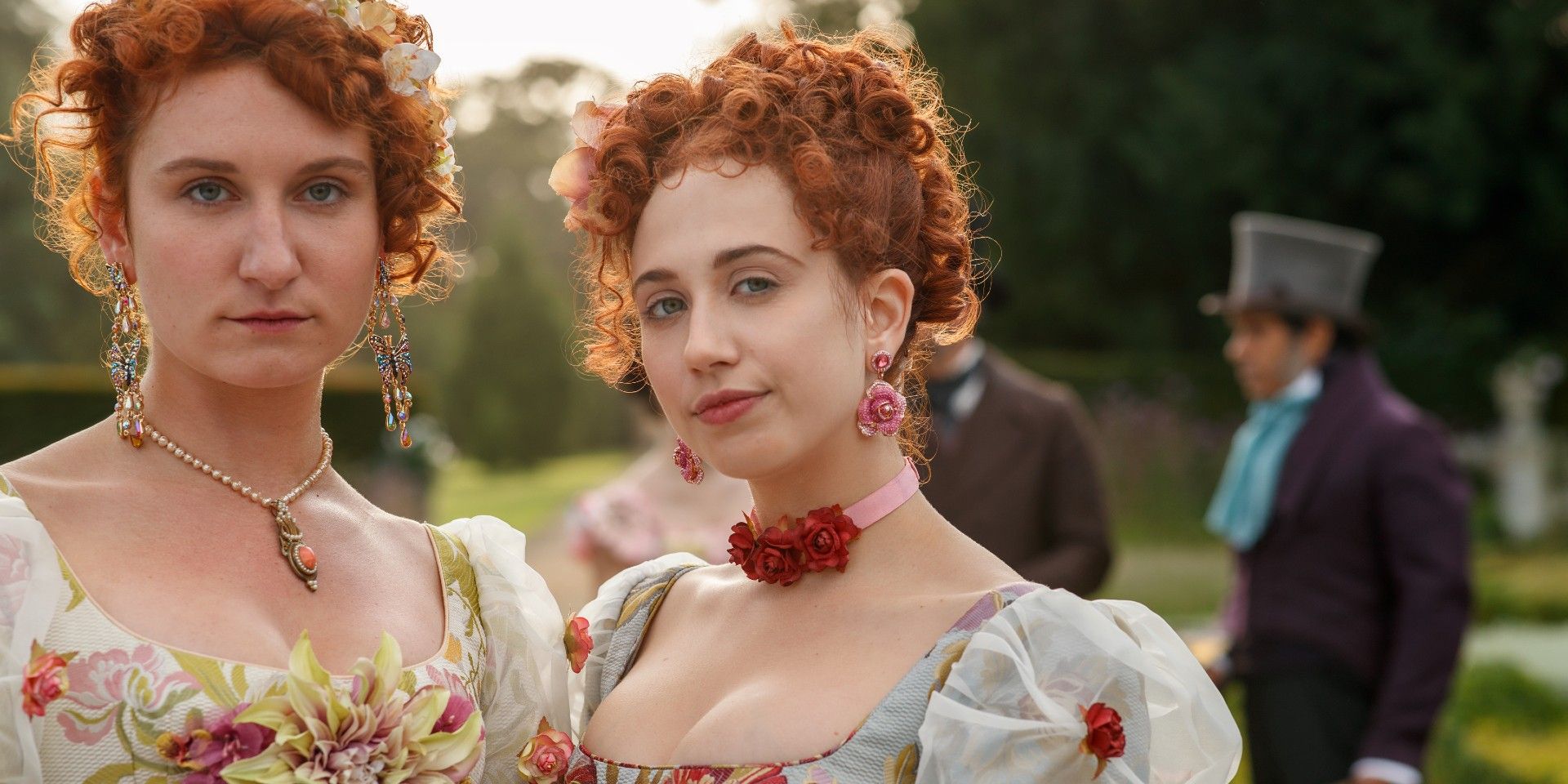
Prudence Featherington’s first scene in Bridgerton sees her suffering through the “tight-lacing” of her corset, but fashion-conscious viewers may notice that this process is at odds with the flowy, loose-fitting dress she wears over it. In fact, while the “tight-lacing” of Prudence’s corset at the behest of Lady Featherington (Polly Walker) represents a popular trope in period dramas, it’s actually historically inaccurate for the Regency era (defined broadly as 1795-1837).
When Prudence Featherington (Bessie Carter) is first introduced, she grimaces in pain as the laces on her corset are being pulled impossibly tight. This is intended to make her appear as thin as possible for her presentation to Queen Charlotte (Golda Rosheuvel) at the opening of Prudence’s third season out in society. When Penelope protests the rough treatment of her sister, Lady Featherington retorts, “I was able to squeeze my waist into the size of an orange and a half when I was Prudence’s age.”
Whether true or not, there would have been no need for Prudence to be able to squeeze her waist into the size of an orange and a half. Stays were more popular than corsets during the Regency era when Bridgerton is set, and they weren’t meant to (nay, couldn’t) be tight-laced. Furthermore, despite what Hollywood (and some popular historical accounts) would have us believe, tight-lacing was not historically common – especially in the pre-Victorian era. According to Michelle Honig in Bustle:
“Although tight-lacing – where women laced their corsets too-tight to create a tiny waist – had come into fashion during a brief period during the Victorian era, it was not widely practiced. But the fact that it was practiced at all inspired satirical newspaper items and cartoons (by men, of course) lampooning (and exaggerating) the lengths women would go to slavishly follow the whims of fashion.”

More importantly, Regency-era perceptions of beauty were different from today and it wasn’t necessarily fashionable to appear as small as possible. This idea is supported by popular clothing styles at the time. Pillar gowns with empire waistlines that sat just below the bust were all the rage. The Regency-style dress rarely shows off the wearer’s hips or waistline, rendering the practice of tight-lacing rather pointless. This means that – while Bridgerton is unapologetically modern and decidedly not historically accurate – Prudence’s tight-lacing still makes no sense.
Prudence Featherington is cinched into a corset so tightly that she can barely breathe, and then immediately puts on a gown that doesn’t hug her waist. It probably wouldn’t have made that much of a visual difference for Prudence to wear her corset a bit looser, thereby sparing her the shame of fainting in front of Queen Charlotte. Because of the dress that Prudence wears over her corset, the fact that her corset was tightly laced makes no sense. One possible explanation, though, is that Lady Featherington is not supposed to be fashionable. After all, she wears dresses that accentuate her waist during a time when that wasn’t in style. It makes sense, then, that she would force her daughter into an unfashionable undergarment that accentuates her waist as well.
More likely, though, is the explanation that our modern perceptions of beauty have shaped our historical perceptions of corsets. In other words, because a corset could conceivably be used to make someone appear smaller, we assume that’s how it must have been used because, in modern society, a smaller waist is widely considered to be more beautiful. Bridgerton’s creators and costume designers might have intended for the scene to be inaccurate because of what it would symbolize through a modern lens: patriarchy and unrealistic beauty standards.
However, corsets (as well as stays) were not historically considered to be the torture devices that Gone With the Wind, Pirates of the Caribbean, and now Bridgerton would have us believe. The intended purpose of corsets was not to force a person’s body into a contraption that distorted their organs and restricted their breathing, but merely to function as a supportive undergarment. And though women’s fashion has too often skewed toward being impractical and restrictive, corsets have somewhat undeservedly been reduced to a trope in Hollywood because of scenes like the one in Bridgerton.
Originally from https://screenrant.com/bridgerton-prudence-featherington-corset-tightlacing-inaccurate/
